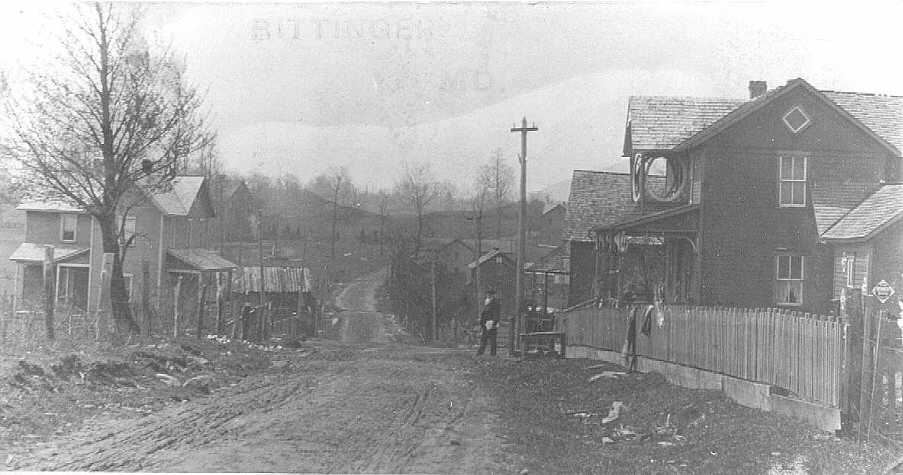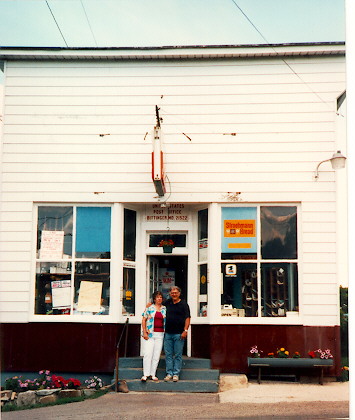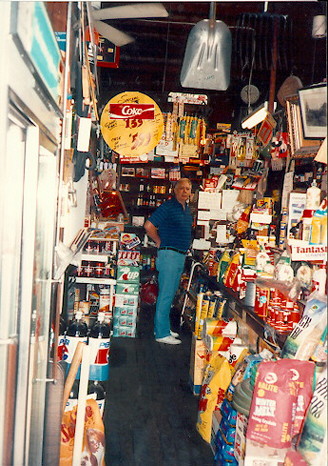

Bittinger, Maryland, ca. 1910
The road you see is now Route 495 or
the Bittinger Road. On the right you see in foreground the store and house of
Oliver Buckel. Oliver was the grandfather of the current owner of the store,
Gary Buckel. The store pretty much looks the same as it did when Oliver owned
it. Beyond the store on the same side is first a house supposedly owned by a
Bittinger and beyond that is the home of Chauncey Elithorpe and wife, Mahala
Brodwater. Their daughter married Asa Orendorf. The Bittinger home is no longer
there but Mrs. Roy Beitzel now lives in the Elithorpe house. On the left side of
the road is the Jerome Emory House. As a young man Jerome loved to play ball
with the local kids. One day he was hit in the eye with a baseball and lost the
sight in that eye. In a short time the other eye also went blind. Since he could
no longer see, his father in law, Thomas B. Wiley, financed and had built this
home for Jerome and Laura Wiley Emory. The builder was Simon Brenneman. Jerome
learned several new trades that could be handled by a man with no sight. His
grandson, Bill Emory, now lives in the house. The man you see in the road was
the Rev. J.B. Shoup, pastor at Emmanuel Lutheran Church. The Reverend's
daughter, Ruth Shoup, married Oliver Buckel. You may not be able to see it but
this is the crossroads where the Bittinger Road is crossed by Legeer Road on the
right by the Buckel store, and by Brenneman Road on the left beside the Emory
house. Brenneman Road is the location of Emmanuel Lutheran Church.
This
German settlement first called the Forks was eventually named for Henry
Bittinger. This tract of land was called "Briar Patch" and parts of military
lots 2134, 2281, 2283 and 2293, which were allotted to Lt. Isaac Duvall for
services in the Maryland Line. It was sold to Henry (Bedinger) of Somerset, Pa.,
who then became the first settler of Bittinger, Maryland.
Military lots
2409-10-11-12 were awarded to General William Smallwood, of the Maryland Line,
Revolutionary War. Smallwood was George Washington's neighbor and aide. The land
was sold to John B. Armstead and in 1832 he deeded it to Henry Ruckle who then
sold it to Peter Lohr. This is the land where the Bittinger Lutheran Church, the
Bittinger Cemetery, the Bittinger Firehall are located at this time.
Other early settlers of this region included Henry and Catherine Buckle, George
and Francis Stark, Peter and Catherine Lohr and the families of John Beachy and
Joseph Buckel.
The first post office at Bittinger was opened in 1885,
with Josiah Bittinger serving as the first postmaster.
The village then
was comprised of maybe 10 homes, a general store, a shoemaker shop, two
blacksmiths, a cooper shop, a church, a school and a one room building used for
making commercial cottage cheese. Bittinger was then in its heyday. Clarence
Brenneman ran a harness and shoe repair shop. "Professor" W.A. Althers taught
singing.
Now, in 2001, the same families still live in Bittinger plus
some newcomers. It's largely a farming area. The Bittinger Emmanuel Lutheran
replaced their 125+ year old church with a new one to accommodate the newcomers,
but the new church still sits on the lot that once belonged to General
Smallwood. On two sides of the church are cornfields. Across from the church is
the Bittinger Cemetery and to the left of the church is the Bittinger Firehall,
which began life as the Bittinger School. The old school is still a part of this
building.
Atop the Appalachian Plateau, Bittinger is subject to severe
winter weather but it has yet to deter the people from turning out on Christmas
Eve for Candlelight Service.
Just my opinion, but I truly believe God's
presence is felt here as in no other place I've ever been.

Buckel's Store was built about 1900 by Oliver Cromwell Buckel. It is now owned
and operated by his grandson, Gary Buckel, and the interior looks much the same
as it did when Oliver operated it. In one tiny corner is the tiniest post office
still in operation in the United States. The potbellied stove has been replaced
by a more recent coal burning stove, but the locals still gather around it each
day to rehash the latest news and gossip.

Many thanks to Margaret Brenneman H. Wagner for the copy of the 1910 postcard. This same picture appears in the last book of Leo Beachy's pictures underneath one of the same place taken by Leo. I called Maxine Beachy Broadwater and asked for permission to use it just in case Leo took both pictures. Also, thanks to John Georg for helping get this scanned.
Contributed by Connie Beachy
Garrett County MDGenWeb Copyright
Design by Templates in Time
This page was last updated
10/11/2023